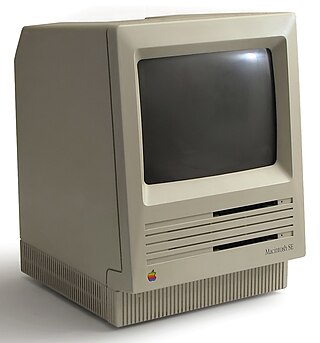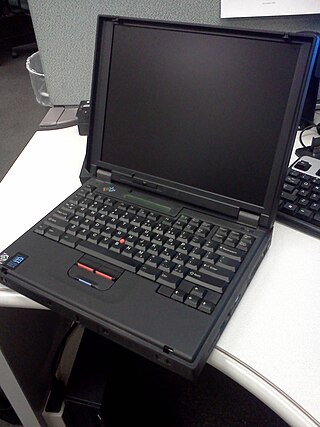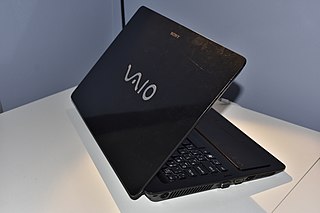External links
Vaio product lines | |||||||
|---|---|---|---|---|---|---|---|
| Desktops | |||||||
| Notebooks | |||||||
| Ultraportables |
| ||||||
The Sony Vaio 700 series were Sony's first Vaio branded laptops, starting with the 705 and 707 models, launched in Japan on July 1, 1997, and subsequently in the United States.
The 700 series featured removable 3.5" floppy disk drive, removable 14x CD-ROM, 33.6 kbit/s integrated modem, 12.1" screen, 2.1 GB hard disk drive, 2 MB VRAM, 128 MB maximum RAM, IrDA port, lithium-ion battery, with optional second battery and an optional docking station with firewire, USB, mouse, keyboard, ethernet and SCSI.
The launch models offered an 800x600 screen (705) or 1024x768 screen (707), 256 KB cache, 16 MB (705) or 32 MB (707) RAM a Pentium 1 MMX 150 or 166 MHz CPU, and Windows 95 pre-installed.
The weight with single battery, and CD and floppy disc drive removed was 2.4 kg (5.3 lb).
The 700 series was produced only in 1997 and 1998, later replaced by lighter models.

The Pentium II brand refers to Intel's sixth-generation microarchitecture ("P6") and x86-compatible microprocessors introduced on May 7, 1997. Containing 7.5 million transistors, the Pentium II featured an improved version of the first P6-generation core of the Pentium Pro, which contained 5.5 million transistors. However, its L2 cache subsystem was a downgrade when compared to the Pentium Pro's.

The Macintosh SE is a personal computer designed, manufactured, and sold by Apple Computer, from March 1987 to October 1990. It marked a significant improvement on the Macintosh Plus design and was introduced by Apple at the same time as the Macintosh II.

The PowerBook G3 is a series of laptop Macintosh personal computers designed, manufactured, and sold by Apple Computer from 1997 to 2001. It was the first laptop to use the PowerPC G3 (PPC740/750) series of microprocessors, and was marketed as the fastest laptop in the world for its entire production run. The PowerBook G3 was succeeded by the PowerBook G4.

The Macintosh Quadra 950 is a personal computer designed, manufactured and sold by Apple Computer from March 1992 to October 1995. It replaced the Quadra 900 that was introduced several months earlier, increasing the CPU clock rate of its 68040 CPU from 25 MHz to 33 MHz, and improving the graphics support. The two computers were otherwise identical, including the price. With a Macintosh Processor Upgrade Card installed, this computer is known as the Power Macintosh 950.
The Sony U series of subnotebook computers refers to two series of Sony products the PCG-U and the VGN-U. The later VGN-U were, at their release, the smallest independent computers running Windows XP and the most powerful high-end subnotebooks at the time. The VGN-U50 and VGN-U70P models are roughly the size of two DVD cases stacked on top of each other.

The Power Macintosh 6100 is a personal computer designed, manufactured and sold by Apple Computer from March 1994 to March 1996. It is the first computer from Apple to use the new PowerPC processor created by IBM and Motorola. The low-profile ("pizza-box") case was inherited from the Centris/Quadra 610 and 660AV models, and replaced the Macintosh Quadra series that used the Motorola 68040 processor, Apple's previous high-end workstation line.

The Panasonic Toughbook is a line of rugged computers produced and marketed by Panasonic. The first model, the CF-25, was introduced in 1996. The Toughbook brand mainly competes with other lines of rugged computers, such as Dell's Rugged Extreme.

The Compaq Presario 1200 was a line of notebook computers produced between 1998 and 2000 by Compaq as part of Compaq Presario line.

The IBM ThinkPad 380 was a notebook computer series released May 13, 1997 by IBM as part of their ThinkPad laptop series. Notable for incorporating a CD-ROM and a floppy drive, it was considered a mid-range laptop by IBM at the time, and sold well. The series was the successor to the IBM ThinkPad 365.

The history of laptops describes the efforts, begun in the 1970s, to build small, portable personal computers that combine the components, inputs, outputs and capabilities of a desktop computer in a small chassis.

IBM ThinkPad 310 was a notebook computer series introduced in 1997 by the IBM corporation into the market as part of their ThinkPad laptop series. It was succeeded by the ThinkPad 380 series.

IBM ThinkPad 760 was a notebook computer introduced in 1995 by the IBM corporation into the market as part of the ThinkPad 700-series. It was succeeded in 1998 by the ThinkPad 770 series.

IBM ThinkPad 770 was a laptop designed and manufactured by IBM targeted for the business, enterprise and professional user. It was the last lineup in the ThinkPad 700-series, succeeding the 760 as the high-end laptop of the ThinkPad lineup. The line was produced from October 1997 to May 2000, and eventually replaced by the ThinkPad models A20m and A20p.
Sony has used the Z model naming scheme for its high-end ultraportable notebook computers since 2000. Unlike other Sony models, the Z has always been manufactured in Japan or in the United States for some models. Sony stated that production of the Z series would cease at the end of 2012.

The Vaio C1 PictureBook was a series of subnotebooks from Sony's Vaio lineup, branded 'PictureBook' for its webcam and video capture capabilities, a first for portable computers. PictureBooks were lightweight computers, weighing 1kg. They featured 8.9" LCD displays, and were notable for being the first consumer laptop with a built-in webcam.

The Sony Vaio 505 series was a line of ultraportable notebook computers from Sony's VAIO brand. The introduction date in the United States was July 24, 1998.
The Sony Vaio 800 series was a range of Vaio laptops launched in 1998. It was produced until early 1999.

The Vaio F series is Sony's multimedia and gaming orientated laptop series. Launched in January 2010, it replaced the Sony Vaio FW series. Like the preceding model, it features a 16.4" screen, but with Full HD 1920 x 1080 resolution, 240 Hz refresh rate, and LED backlight. The model came in two choices (VPCF2), 2D or 3D models. The 3D model is included with 3D glasses.

The IBM ThinkPad 600 series was a series of notebook computers introduced in 1998 by IBM as an lighter and slimmer alternative to the 770 series. Three models were produced, the 600, 600E, and 600X; the series was succeeded in 2000 by the ThinkPad T20 series.
Armada is a discontinued line of business laptops by Compaq. They started as a more affordable version of the Contura line, but after that, they replaced Contura as a mainstream laptop line, and then the high-end Compaq LTE line were merged with Armada as a premium 7300 and 7700 sub-lines.